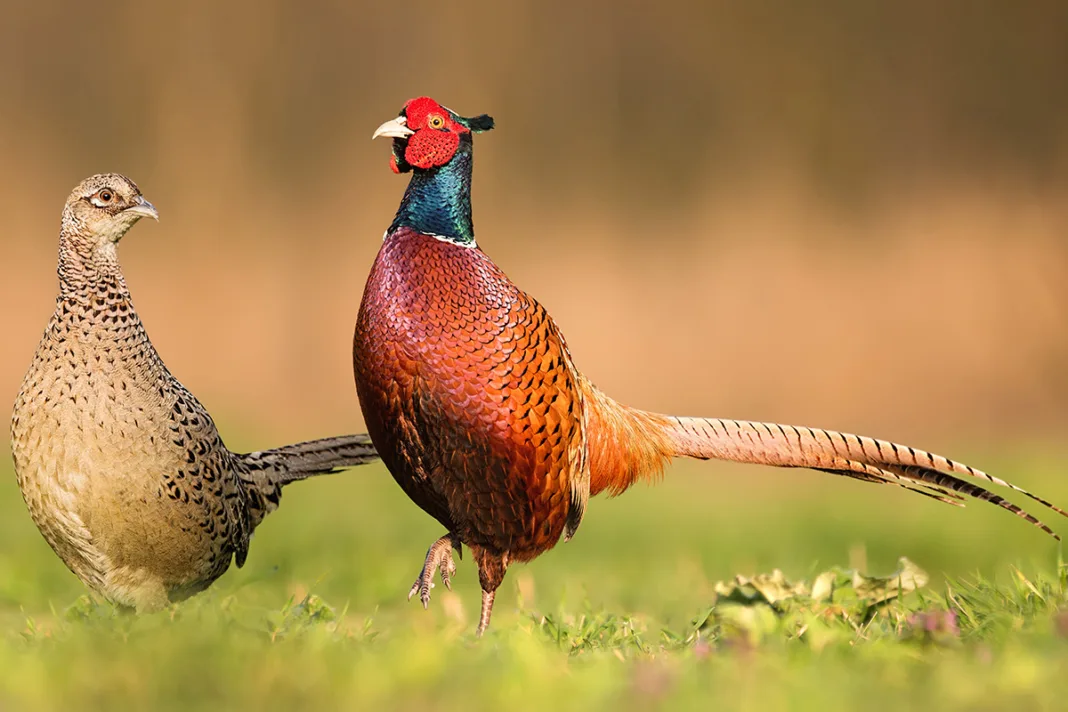The common pheasant: hunted, shot and eaten for hundreds of years. Graham Wellstead looks at the bird’s rich history and role as a premier game bird in established shooting estates
THE common pheasant is seen anywhere in the UK where there is a game estate and almost anywhere there is not! Pheasants spread surprisingly far and, if left in peace to breed, will turn up in the most unlikely places. Where I live could hardly be described as rural (in fact, I am a very square peg in a very round hole), but every now and then I see pheasants, usually lone individuals, in my garden or those of my neighbours. The nearest shooting estate is three miles (5km) away.
It is normal when writing about birds and indeed any living creature, to include the scientific name. In this instance, I do so (Phasianus colchicus) but unwillingly, for the pheasant is such a mix of species that it would more correct to class it as an infinite hybrid. It is not native but introduced – who by? It is generally accepted that the Romans brought the bird here, as they did so many things. What is certain is that it was common by the 15th century.
It is thought of as a game bird, but in the early years, there was no game shooting and a reliable gun was yet to be invented, so either birds were kept in captivity or brought to the table by long- or cross-bow shooting. Pheasant and peafowl, which were also a great table delicacy, would have been kept, probably together, in an enclosure. To produce sufficient numbers for His Lordship’s table when shooting with a longbow, you either had to be an exceptional shot or one of a company.
The bird originates in Asia and quite a number of different distinct species have been added, so there are a number of variants. This includes the Japanese green pheasant (P. versicolor) and ring-necked, be it the Chinese, Mongolian or Korean, all commonly seen, and in America a blue-backed variety has been domestically bred, prized for its high, fast flight. It is generally thought of here as a woodland species, but it does best where there is plenty of undergrowth along the woodland edge to agricultural land or shrubby wetland.
Surprisingly, for the Americans, the non-native ring-necked pheasant is the State bird of South Dakota. As well as species variation, there are also colour mutations, the commonest being melanistic (black) and flavistic (isabelline). On some estates, keepers will introduce white birds, working on the theory that if they disappear then poaching is happening.
Keeping pheasants as an avicultural species usually involves a number of rather more exotic pheasant species, although some, typically Reeves’s (Syrmaticus reevesii), silver (Lophura nycthemera) and golden (Chrysolophus pictus) may be found on a shooting estate. Although it normally involves a fine if you shoot one.
Like many of its relatives, the pheasant is a very colourful bird, yet quite difficult to see in the undergrowth. More so, the cryptically camouflaged hens, which are still beautiful. On shooting days, they can remain almost invisible in a grassy field until you nearly step on them. When teaching animal sciences, I was asked to include an option on gamekeeping for the practical habitat course. As part of the course, I had a small pheasant release-pen built in the woodland and for several years hatched, reared and released about 50 pheasant poults annually. They added something to the estate and very few fell into the clutches of my hunting hawks. Some of their offspring still survive, in spite of no fox control now.
The pheasant has taken over as the premier game bird with most shooting estates and is produced in huge numbers, replacing the much-revered grey partridge (Perdix perdix). Four-fifths of shoots rely on pheasants, with some 35 million birds released each year, of which about 15 million are shot. The number of wild birds is difficult to estimate, but they are likely to provide fewer than 10 per cent of the total.
Graham Wellstead runs Wey Valley Falconry in Surrey.
Find more news and articles like this on the Cage & Aviary Birds website. Subscribe to Cage & Aviary Birds magazine now.


